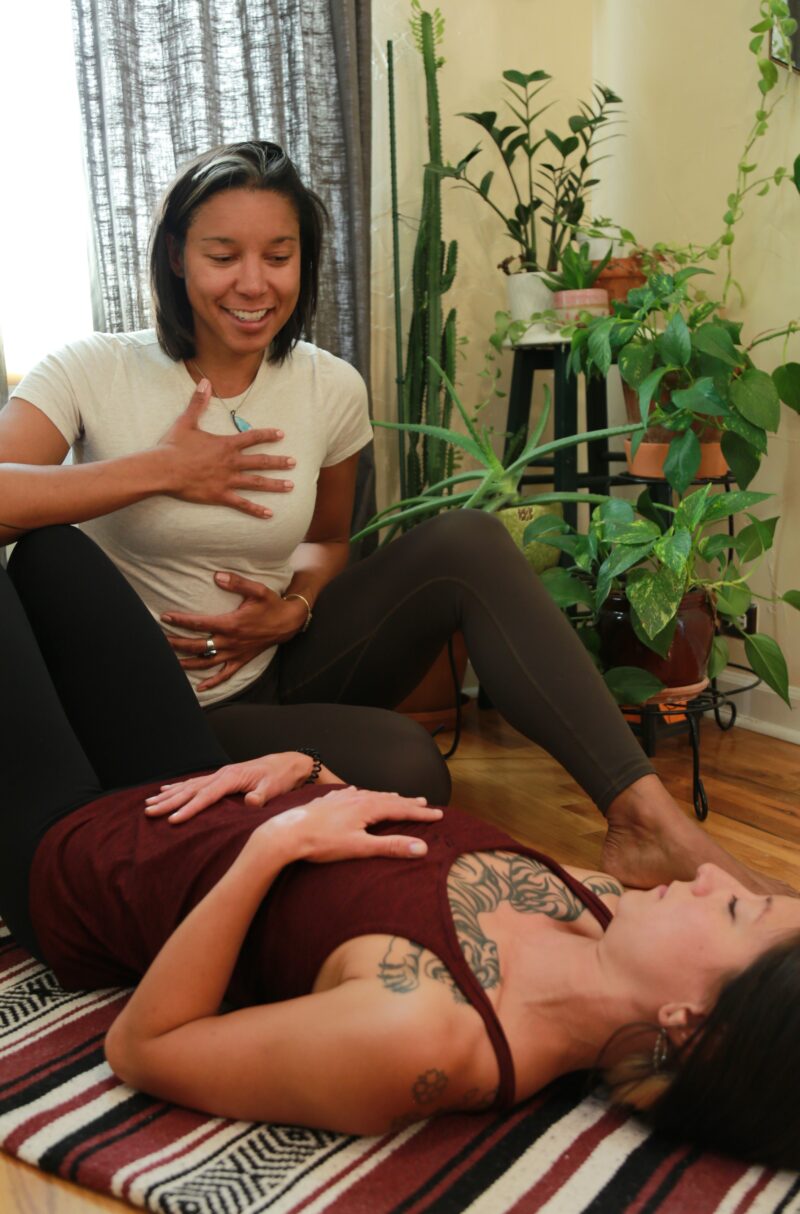Advocate for Your Pelvic Health | By Erin Phillips
Unless we experience “something wrong down there” or receive postpartum care, we often don’t learn about the very core region of our human bodies — our pelvic bowl.
“Pelvic health is so often out of the normal repertoire of health care and our vernacular of how we’ve learned to take care of ourselves,” says Jessa Youngs, a licensed acupuncturist and fertility awareness educator, who holds a master’s in oriental medicine. She owns Embodied Wholeness, which provides holistic cycle and pelvic care in Fort Collins. In this article, Youngs and Rachel Ohene, a licensed occupational
therapist (OT) and owner of Liberate Pelvic Health in Denver, share their experience of why pelvic health education is important, how dysfunction can present itself in all bodies and what interventions are available.
WHY PELVIC EDUCATION IS IMPORTANT

Jessa Youngs, a licensed acupuncturist and fertility awareness educator. Photo courtesy of Jessa Youngs.
“We’re conditioned to be tight in our pelvic bowl, partially because of a toxic sexual culture and a medical system that doesn’t inquire or empower people with their pelvic health,” Ohene believes. She values marketing her practice across all genders, stages of life and backgrounds, especially with marginalized populations, to acknowledge how those factors may play a role in seeking and receiving appropriate health care.
Specialists believe everything is connected into this region, including our spine and nervous system, and the way we behaviorally hold our bodies throughout the day plays hugely into our pelvic health. “We’re not taught to move through our emotions in a healthy way, and when we go through our day stuffing down stress, trauma and emotions, they get held in the pelvic bowl,” adds Youngs. Connective tissues that line every part of our body — bones, muscles, organs, etc. — can store those stress hormones and become tight and tense.
“Beyond musculoskeletal consideration, energetically our pelvic bowls house the sacral chakra, where inspiration, creativity, pleasure and sensuality emerge. Feeling stuck in any of those areas is just as valid a reason to get curious or seek out a practitioner as having something we traditionally consider ‘wrong,’” says Youngs.
DYSFUNCTION CONSIDERATIONS
“There is a huge emphasis on postpartum care, which our society needs, but there’s a lot more to be acknowledged and addressed,” stresses Ohene. “In our traditional medical system, diseases get labeled into one category, such as digestive or reproductive, but they’re systemic immune and endocrine disorders resulting in inflammation and hormonal imbalance. And our mental and emotional well being also plays largely into our cellular and hormonal response,” adds Youngs.
She noticed one common thread among her varied clients is that every single one of them experiences some level of anxiety and tight gripping on to life. “Think about what we call someone that is anxious — a tight- ass,” adds Ohene. “Well, that’s the pelvic floor muscles being tight, and it’s tied into an embodied experience of anxiety, control and hypervigilance.”
In Youngs’ practice, she has only ever seen about 5% of clients having a hypotonic, or weak, pelvic floor. Ohene reports similarly that hypertonicity, or tight pelvic floor, is more prevalent, but, “They go hand-in-hand, and sometimes, the hypotonicity is because of the hypertonicity. The ability to recruit and hold the muscles is impaired when they are always tight and don’t have the full range of function.”
Thinking from the pelvic congestion perspective, Ohene considers that when “10% of tension in the pelvic floor muscles can create up to 50% constriction in its vascular and lymphatic systems; what is that going to do to the overall health of the tissue, organs and everything there?”
BEYOND YOUR TRADITIONAL INTERVENTION

Rachel Ohene, a licensed occupational therapist (OT) and owner of Liberate Pelvic Health in Denver. Photo courtesy of Rachel Ohene.
“Coming into awareness is 90% of healing, always. The other 10% is the few things that we actually have to change and shift,” shares Youngs. Amazingly, there are a wide range of interventions available. For both Youngs and Ohene, trauma-informed, holistic care is vital. They solicit sovereignty, autonomy and informed consent with the approaches that the client is most interested in. Ohene says, “I always want to work myself out of a job by empowering people with their own experiences, knowledge and tools.”
Youngs emphasizes deeply nourishing and feminine care that is cyclically and pelvic attuned. She offers interventions such as pelvic bowl chi gong, yoni steaming, Maya abdominal massage, grounding somatic work, acupuncture and cyclical-living education resources. “The biggest piece is to come away with presence,” says Youngs. “I’m holding space for the client to learn to re-hold themselves.”
As an OT, Ohene loves working with the subtler body components, like pelvic congestion, vascular and lymphatic systems, chakra energy centers, myofascial systems, neuromuscular processing and functional movement and postural realignment. “It is really important to teach people how to safely be in their body. Pushing your body may reinforce maladaptive movement patterns,” Ohene cautions. She’s also trained in the occupational narrative, that storytelling piece. “I’m actively listening and creating a space for someone to tell their lived experience and to be witnessed in it, which is different from psychoanalyzing it,” she believes.
“It’s really about inviting the body to see what it’s able to release,” says Ohene. “That comes with helping to regulate the client’s nervous system so that they can develop curiosity and different ways to experience and breathe into the nuances of the body. If I feel the tension release, but the patient doesn’t, the change isn’t going to stay. Can they bring awareness to their pelvis while brushing their teeth or driving?”
FIND A PRACTITIONER YOU TRUST
“Health advocacy is so important, so the client can be informed on recognizing pelvic dysfunction to advocate for their own health,” continues Ohene. “Without that, the doctor’s approach is likely going to be labs and a speculum, which can create trauma to a tight pelvic floor and a rupture, in turn, leading to internalizing a sense of brokenness.”
Advocate for finding the practitioner that you trust and vibe with, just like you would with a psychotherapist over the course of your mental health healing. The world is vast, and there are a lot of differing and emerging opinions, so allow it to be a healing journey in which different practitioners along the way give you the healing nuggets.
To learn more about Jessa and her offerings, visit embodiedwholeness.org or follow @jessa.youngs. To learn more about Rachel and her offerings, visit liberatepelvichealth.com or follow @liberatepelvichealth.
Originally published in Summer + Fall 2023 issue of Colorado YOGA + life.

ERIN PHILLIPS
Writer + Adventure Photographer
@erinmp93
erinmariedesigns.com
Destined to be your daily companion, this backpack to tote-bag is an ideal piece from morning to evening. [...]

Subscribe to Our Tribe
Stay up to date with Y+L News, Events and special announcements.










